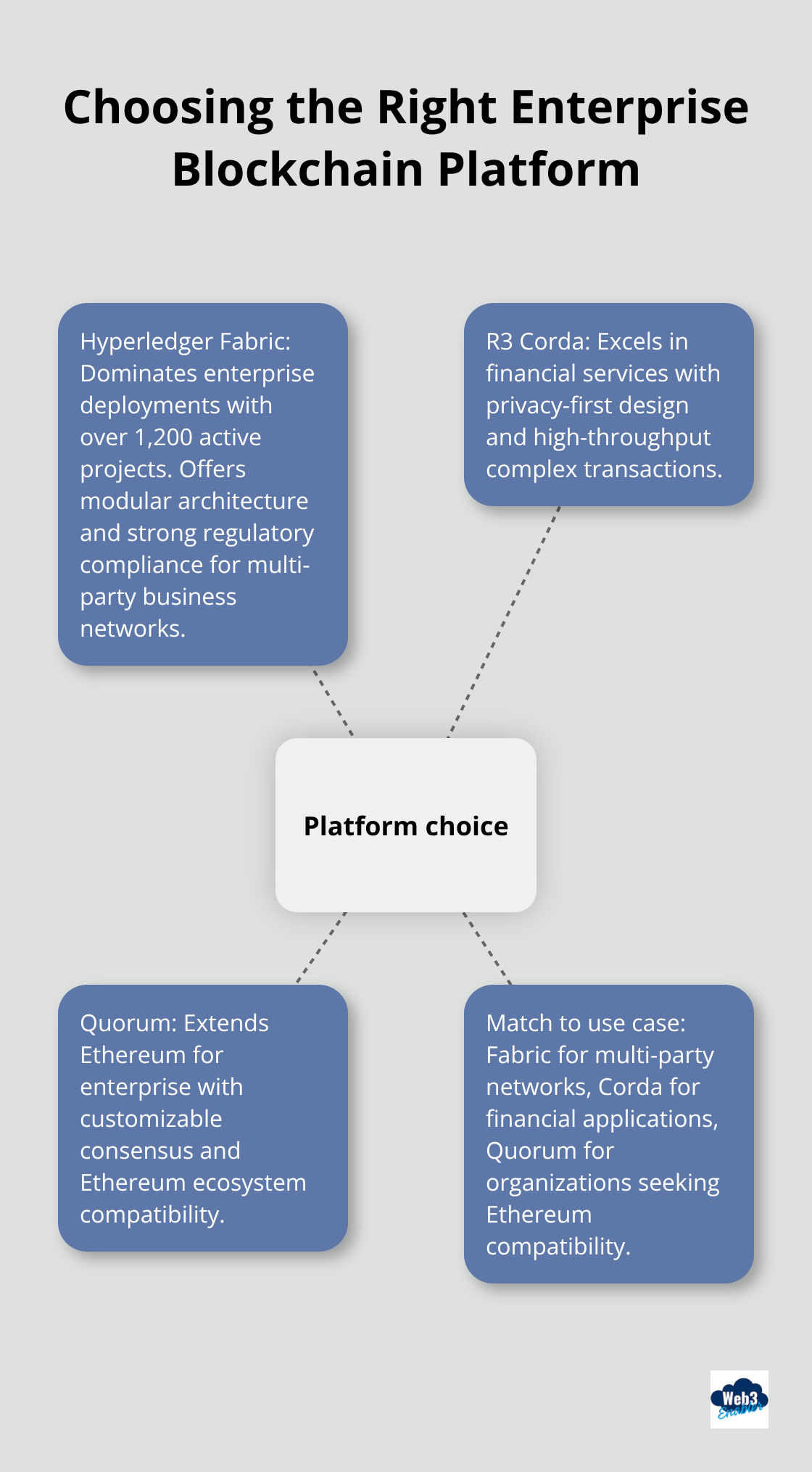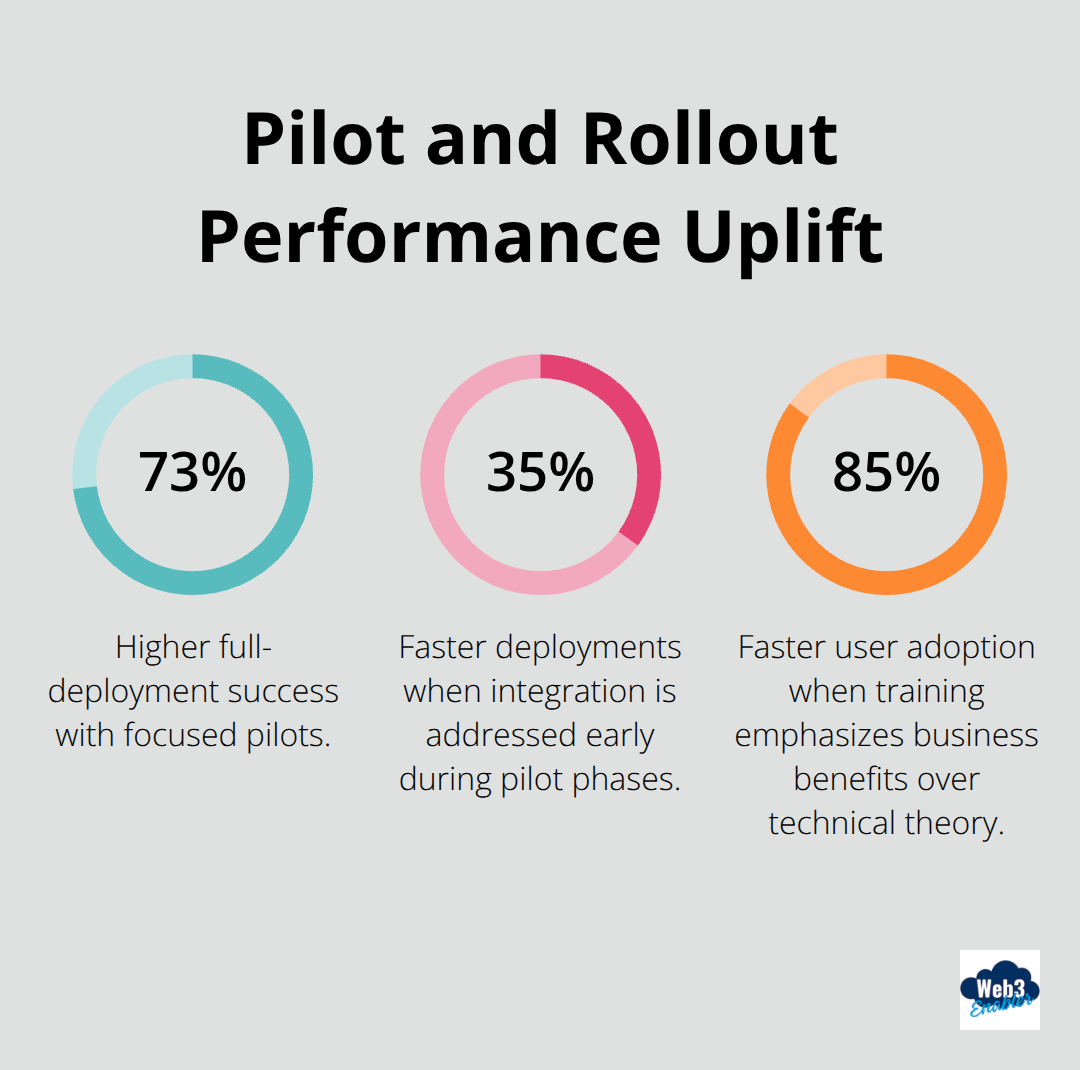
Enterprise blockchain adoption has accelerated dramatically, with 81% of executives now viewing distributed ledger technology as mainstream according to Deloitte’s survey.
Yet most organizations struggle with implementation complexity and integration challenges. We at Web3 Enabler have created native tools to guide 150,000 companies into successful blockchain deployments.
This guide breaks down the practical steps to transform your enterprise operations with blockchain technology.
What Makes Enterprise Blockchain Different
Enterprise blockchain operates under completely different rules than the consumer side. With consumer blockchain deployments, the user self educates. With enterprise blockchain deployments, standardization of practices is important. Alternative systems, that avoid public blockchains and instead use private blockchain networks – give you full control over who participates, what data they access, and how transactions get processed. Research shows that distributed ledgers can reduce compliance and transaction costs when companies implement them correctly, but only if you choose the right architecture from the start.
Network Architecture and Access Control
Your enterprise blockchain must prioritize permission-based access over open participation. Permissioned networks allow only verified participants to join, which protects sensitive business data during transactions. This approach has proven successful across industries, with integrated shared ledgers in shipping reducing documentation costs and cutting door-to-door delivery times according to recent pilot studies. The key difference lies in consensus mechanisms – enterprise systems use Proof of Authority or Byzantine Fault Tolerance instead of energy-intensive mining, achieving transaction speeds of thousands per second versus Bitcoin’s seven transactions per second.
Integration and Scalability Requirements
Your existing ERP and CRM systems need seamless blockchain integration without disruption to current operations. The enterprise blockchain market is projected to grow significantly, driven largely by successful legacy system integrations. Smart contracts automate business processes and reduce manual errors, with the smart contract market expected to experience substantial growth in the coming years.
Common Implementation Pitfalls
Most implementation failures stem from inadequate technical infrastructure planning and insufficient internal blockchain expertise during the initial deployment phase. Organizations often underestimate the complexity of connecting blockchain networks to existing databases and workflow systems (particularly in regulated industries). The lack of standardized frameworks continues to push companies toward more integrated solutions that can bridge traditional systems with blockchain technology.
With these foundational differences in mind, your next step involves developing a comprehensive strategy that aligns blockchain capabilities with your specific business objectives.
How Do You Build Your Blockchain Strategy
Your blockchain integration strategy starts with the identification of specific operational pain points that distributed ledger technology can solve profitably. Companies that focus on concrete business problems see 40% higher implementation success rates compared to those that pursue blockchain for technology’s sake alone. Start by examining your most expensive manual processes – cross-border payments, supply chain documentation, or multi-party reconciliation. These areas typically offer the highest return on blockchain investment, with shipping companies leveraging blockchain technology for enhanced supply chain sustainability performances.
Target High-Impact Use Cases First
Focus your initial blockchain deployment on processes that involve multiple parties, require extensive documentation, or suffer from trust issues between participants. Payment processing stands out as the most practical starting point, with blockchain payments settling in under 3 minutes versus 3-5 business days for traditional bank transfers. Cross-border payment costs drop from 2-7% to just 0.5-1% when you use blockchain infrastructure. Supply chain traceability represents another high-value target, with this market expected to exceed $3.55 billion in 2025 and growing at 31% annually. Avoid complex multi-use case implementations initially – companies that start with single-purpose blockchain solutions achieve deployment 60% faster than those that attempt comprehensive overhauls.
Platform Selection Based on Real Requirements
Hyperledger Fabric dominates enterprise deployments with over 1,200 active projects globally (particularly in supply chain and financial services applications). This platform offers modular architecture and strong regulatory compliance features that most enterprises require. R3 Corda excels in financial services with its emphasis on privacy and high-throughput complex transactions, while Quorum extends Ethereum capabilities for enterprise use with customizable consensus algorithms. Your platform choice should align with your primary use case – Fabric for multi-party business networks, Corda for financial applications, and Quorum for organizations that want Ethereum ecosystem compatibility.

Build Technical Capabilities Strategically
Your internal team needs three core competencies: blockchain architecture understanding, integration expertise with existing systems, and regulatory compliance knowledge. Start by training your existing IT staff rather than hiring exclusively blockchain-focused developers – companies report 50% better integration outcomes when they leverage internal system knowledge. Partner with specialized blockchain development firms for initial implementation while you build internal capabilities. This hybrid approach reduces deployment risks while it creates sustainable long-term expertise within your organization.
Address Integration Complexity Early
Legacy system integration presents the biggest technical challenge for most enterprises (with ERP and CRM systems requiring careful API development and data mapping). Your blockchain network must communicate seamlessly with existing databases without disrupting current operations. Companies that address integration requirements during the planning phase complete deployments 35% faster than those that treat integration as an afterthought. Test data flows between your blockchain network and existing systems before full deployment to identify potential bottlenecks or compatibility issues.

With your strategic foundation in place, the next phase focuses on the practical steps that turn your blockchain strategy into a working system through careful pilot program development and systematic deployment practices.
How Do You Execute Flawless Blockchain Deployment
Your pilot program must start with a single, measurable use case that delivers results within 90 days. Companies that run focused pilots see 73% higher full-deployment success rates compared to those that test multiple blockchain applications simultaneously (according to IBM’s enterprise blockchain research). Select your highest-pain manual process – vendor payments, invoice reconciliation, or cross-border transfers work best for initial tests. Set specific metrics before launch: payment settlement time reduction, documentation cost savings, or error rate improvements.

Your pilot should involve 3-5 trusted business partners maximum to maintain control and gather meaningful feedback. Test with real transactions but limit financial exposure to $10,000-50,000 initially.
Security Architecture That Actually Works
Your blockchain network requires multi-layered security controls that go beyond standard enterprise IT practices. Implement hardware security modules for private key management and multi-signature approval processes for high-value transactions. Fireblocks secures over $10 trillion in digital asset transfers through their comprehensive security framework, which demonstrates the importance of institutional-grade protection. Your network must include real-time transaction monitoring, automated threat detection, and immediate incident response protocols. Companies that experience security breaches face average recovery costs of $4.45 million according to IBM’s security research. Never store private keys in standard databases or cloud storage – use dedicated key management systems with proper access controls.
Employee Adoption Through Practical Training
Your staff training must focus on workflow changes rather than blockchain technology theory. Start with the finance team since they handle most blockchain-related processes like payment approvals and reconciliation. Create step-by-step process guides for common tasks: payment initiation, transaction verification, and exception handling. Companies report 85% faster user adoption when training emphasizes business benefits over technical details (rather than theoretical presentations). Schedule hands-on workshops with your actual blockchain interface. Your employees need to understand exactly how their daily tasks change – payment approval times, new verification steps, and updated reporting requirements. Train department heads first so they can support their teams during the transition period.
Integration Testing and Validation
Your blockchain system must connect seamlessly with existing ERP and CRM systems before full deployment. Test data flows between your blockchain network and current databases to identify potential bottlenecks or compatibility issues. Companies that address integration requirements during pilot phases complete deployments 35% faster than those that treat integration as an afterthought. Run parallel processing for 30-60 days to compare blockchain results against traditional methods. Monitor transaction accuracy, processing speed, and system stability throughout the testing period. Document all integration points and create backup procedures for system failures or network disruptions.
Final Thoughts
Successful enterprise blockchain implementation demands focused execution on three key factors: start with high-impact use cases, build robust security architecture, and train teams on practical workflow changes rather than technical theory. Companies that follow this structured approach achieve 73% higher deployment success rates and complete implementations 35% faster than organizations that attempt comprehensive overhauls without proper planning. The focused approach eliminates common pitfalls that derail blockchain projects.
The long-term benefits extend far beyond initial cost savings. Your organization gains 24/7 payment processing capabilities, eliminates chargeback risks, and reduces cross-border transaction costs from 2-7% to just 0.5-1%. Enterprise blockchain creates permanent audit trails, automates reconciliation processes, and enables real-time visibility across all financial operations (with companies reporting sustained efficiency gains years after initial deployment).
Ready to start your blockchain transformation? Web3 Enabler provides blockchain solutions trusted by industry leaders like Circle, Ripple, and Cardano. We specialize in seamless integration with existing business systems and offer custom implementations to help businesses integrate blockchain technology into their workflows. Your next step involves scheduling a consultation to identify your highest-value blockchain use case and develop a deployment timeline that fits your operational requirements.









